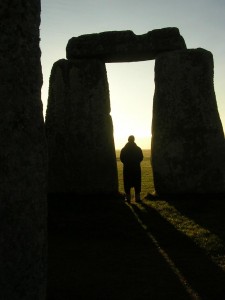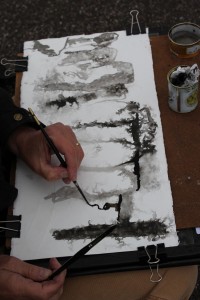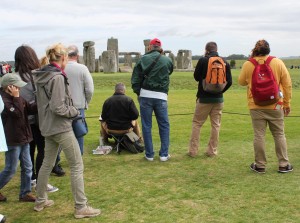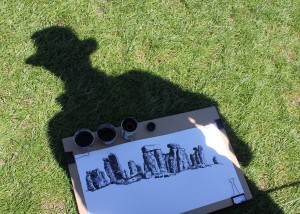Stonehenge – the Mid Point
We’re half way through our year, our Grand Tour of Stonehenge, and I thought I’d put some questions to Mark – things that have occurred to me, and questions that other people have posed during the past six months to see what’s going on in the artist’s head.
Gabi – Mark, you’re drawing these stones so that you can learn them, but why don’t you just take a photograph and learn them from a photograph? Why do you have to draw them on site?
Mark – I’m drawing the stones because to photograph them is not the same. To photograph is nothing like the process of drawing an object from observation. A photograph is an image built up technologically, whereas to draw something is to travel it in detail, to allow your eye sometimes to wander, sometimes to be specific, and find a route through, to learn incrementally in different measures. It’s much more particular than photographing. Even if one was to photograph and reproduce that photo in great detail, it will be a drawing of a photograph of Stonehenge, it won’t be a drawing of Stonehenge, and I think there is a strong distinction.
Gabi – Given that Stonehenge is one of the windiest places known to man and that you’ve already had a pot of ink blown over you, why are you persisting in drawing in ink?
Mark – Ink is a good technique for drawing outside even despite rain and wind because it’s very expedient. It’s very fast and you can achieve lots of different types of marks, lots of very distinct and different tones with very little choice. You can make different marks with a brush or a pen or your finger or whatever. That’s really good in the case of the stones because the stones are comprised of many different layers. You have the stones themselves, the surface, lichen, you have cracks, you have the way the stones are dressed. You can actually represent these in slightly different and quite distinct ways by deciding a code or system for yourself and that’s a great way to then look back at the drawings and understand and unpeel the layers.
Gabi – Why have you decided that a whole year is the right amount of time to draw and learn the stones? Could you not do it for less time?
Mark – I don’t think I could take less time drawing the stones. It’s quite a nice amount of time, from solstice to solstice, that’s a whole season. It’s also nice to have a deadline for me, so it becomes a kind of clock. I know there are certain systems, certain methods, techniques and accumulations of image I have to do within a certain time. There are different phases of learning, different phases of drawing. The other reason is – there is so much detail. The light changes from minute to minute, never mind week to week and from season to season. Also there’s so much particular detail that one needs to tune in to. It’s quite easy to create nice looking impressions of the stones because they’re so atmospheric. The landscape around you gives such drama. When you start to specify actually what they are, to draw their anatomy, you need to take time to do that. It’s like learning the anatomy of an animal you’ve never seen. It takes an enormous amount of time to make it credible.
Gabi – How does it feel having so many people staring over your shoulder when you’re trying to work?
Mark – It’s a mixed blessing. It’s nice to have the sense that people are actually engaging with the process of drawing, which I’m a great advocate of. People are still interested in drawing. That’s fantastic. There is still a kind of wonder, and I’m not saying it’s because of my skill, but the skill generally, that one can conjure something from the hand and the eye and material. It can be good, and then it can be really difficult, because you’re never alone, never truly alone. You always have this feeling that someone’s looking at what you’re doing and you can’t really get rid of that. It’s like when you perform. You can practice by yourself, but the moment there’s someone else in the room it affects the results. It’s just not allowing that to alter the credibility of what you’re doing.
Gabi – What’s the worst behaviour you’ve had from anybody witnessing you doing your work?
Mark – Some people can be really intrusive, is the truth. It could be excitement; it could be their idea of personal space is very different to mine. But, the worst excesses are people backing into you without knowing, people just getting too close to see exactly what you’re doing, and the very worst thing is someone sticking a camera about four inches from my face and taking a photograph with a flash.
Gabi – What is it about Stonehenge that resonates with you?
Mark – I love Stonehenge because it’s still. Everything around Stonehenge is moving, whether it’s military helicopters or traffic, or people going round and round it, and coaches coming and going, even nature, moving constantly. And the wind is constantly moving and bringing fronts in, then going. And Stonehenge is just there and it’s just still. And everything in our world for good or ill is moving faster and faster and faster. And everyone’s taking lots of photographs and downloading them the minute they’ve taken them and yet this thing, which is material, is rooted to the ground. It is the only thing that’s rooted and still. And for some reason, that now attracts me more than ever.
Gabi – Do you see them, the sarsens, as art?
Mark – Yes I do. I see them as art, but I don’t really know where I can take that. I mean, they’re as much art for me as many other sculptural forms that have been made to articulate something or, something built in the environment. They’re as art as the Temple of Karnak, or the Pyramids or some great gothic cathedrals. So there’s craftsmanship and art. They’re not art in the terms of how we see a lot of contemporary art – an individual vision of the world, but who knows? They may well have been. They may have been here to articulate an idea, an abstract notion, a feeling, to provoke something in relation to something else in the landscape. That would make it more Art than a lot of stuff out there now calling itself Art. So without knowing the intention, I would say they’re like art. They’re like Michelangelo sculptures. They’re beautifully dressed, the form is extraordinary and they’re still magnetising.



